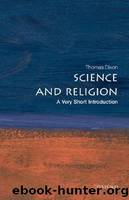Science and Religion: A Very Short Introduction by Dixon Thomas

Author:Dixon, Thomas [Dixon, Thomas]
Language: eng
Format: epub
Tags: History
ISBN: 9780199295517
Barnesnoble:
Goodreads: 2190593
Publisher: Oxford University Press, USA
Published: 2008-09-01T00:00:00+00:00
13. Cartoons from Vanity Fair depicting Professor Thomas Huxley and Bishop Samuel Wilberforce, whose encounter in Oxford in 1860 became legendary
that they had won the day. But by the time the tale came into wider circulation a couple of decades later, Huxley and Hooker, who had long been pressing for the autonomy of science from the Church, had risen to positions of much greater influence. The ascendancy of the professionalizing agnostics within the British scientific establishment was witnessed by the fact that both Hooker and Huxley were chosen to serve as Presidents of the Royal Society. The Huxley-Wilberforce story was then used retrospectively, as a piece of victors’ history, to suggest a clearer triumph for scientific naturalism over Anglican conservatism than had really been achieved in Oxford in 1860. It suited the new elite to be able to tell the story in a way that seemed to foreshadow and legitimize their own rise to power, while simultaneously depoliticizing the issue. The 1860 confrontation between Samuel Wilberforce and Richard Owen, on the one hand, and the young Darwinians, on the other, had resulted from a struggle for dominance within the institutions of British science and education – a conflict between competing social interests as well as between competing interpretations of the scientific evidence for evolution. The later recasting of the Huxley-Wilberforce debate as one more instance of a simple and timeless conflict between ‘science’ and ‘religion’ helped to suggest that the agnostics’ rise to power was the result of an inexorable historical process rather than a deliberate political campaign.
Evolution and theology
Wilberforce’s review of On the Origin of Species identified the theological issues which would play out repeatedly among Christians, Jews, Muslims, and others as they considered the implications of evolution for their religious beliefs in the 19th century and afterwards. Some of these were not new. Discoveries in astronomy and geology had already given theologians plenty of opportunity to discuss the relative authority of science and scripture in determining natural knowledge. Darwin’s view of nature drew particular attention to suffering, violence, and death. But people hardly needed Darwin to tell them that these were features of the natural world in general and of human life in particular. Again, theologians were already aware of the problem of evil, and had various responses to it. One common response to human evil was to explain that God must allow his creatures free will, which could be turned to either good or evil ends. Bishop Wilberforce’s response to Darwin’s remarks on imperfections in nature, and on the apparent cruelty of such creatures as the ichneumon wasp, was to refer to the Christian idea of the Fall. On this view, when Adam and Eve, the crowns and rulers of creation, were expelled from the Garden of Eden for their disobedience, it was not just they and their human descendants who fell from grace into a disordered state; it was the whole of nature. As Wilberforce put it, the ‘strange forms of imperfection and suffering amongst the
Download
This site does not store any files on its server. We only index and link to content provided by other sites. Please contact the content providers to delete copyright contents if any and email us, we'll remove relevant links or contents immediately.
The Lost Art of Listening by Michael P. Nichols(6472)
Why I Am Not A Calvinist by Dr. Peter S. Ruckman(3769)
The Rosicrucians by Christopher McIntosh(3049)
Wicca: a guide for the solitary practitioner by Scott Cunningham(2704)
Signature in the Cell: DNA and the Evidence for Intelligent Design by Stephen C. Meyer(2500)
Real Sex by Lauren F. Winner(2474)
The Holy Spirit by Billy Graham(2414)
To Light a Sacred Flame by Silver RavenWolf(2353)
The End of Faith by Sam Harris(2287)
The Gnostic Gospels by Pagels Elaine(2026)
Nine Parts of Desire by Geraldine Brooks(2006)
Waking Up by Sam Harris(1958)
Heavens on Earth by Michael Shermer(1954)
Devil, The by Almond Philip C(1899)
Jesus by Paul Johnson(1887)
The God delusion by Richard Dawkins(1848)
Kundalini by Gopi Krishna(1824)
Chosen by God by R. C. Sproul(1759)
The Nature of Consciousness by Rupert Spira(1689)
